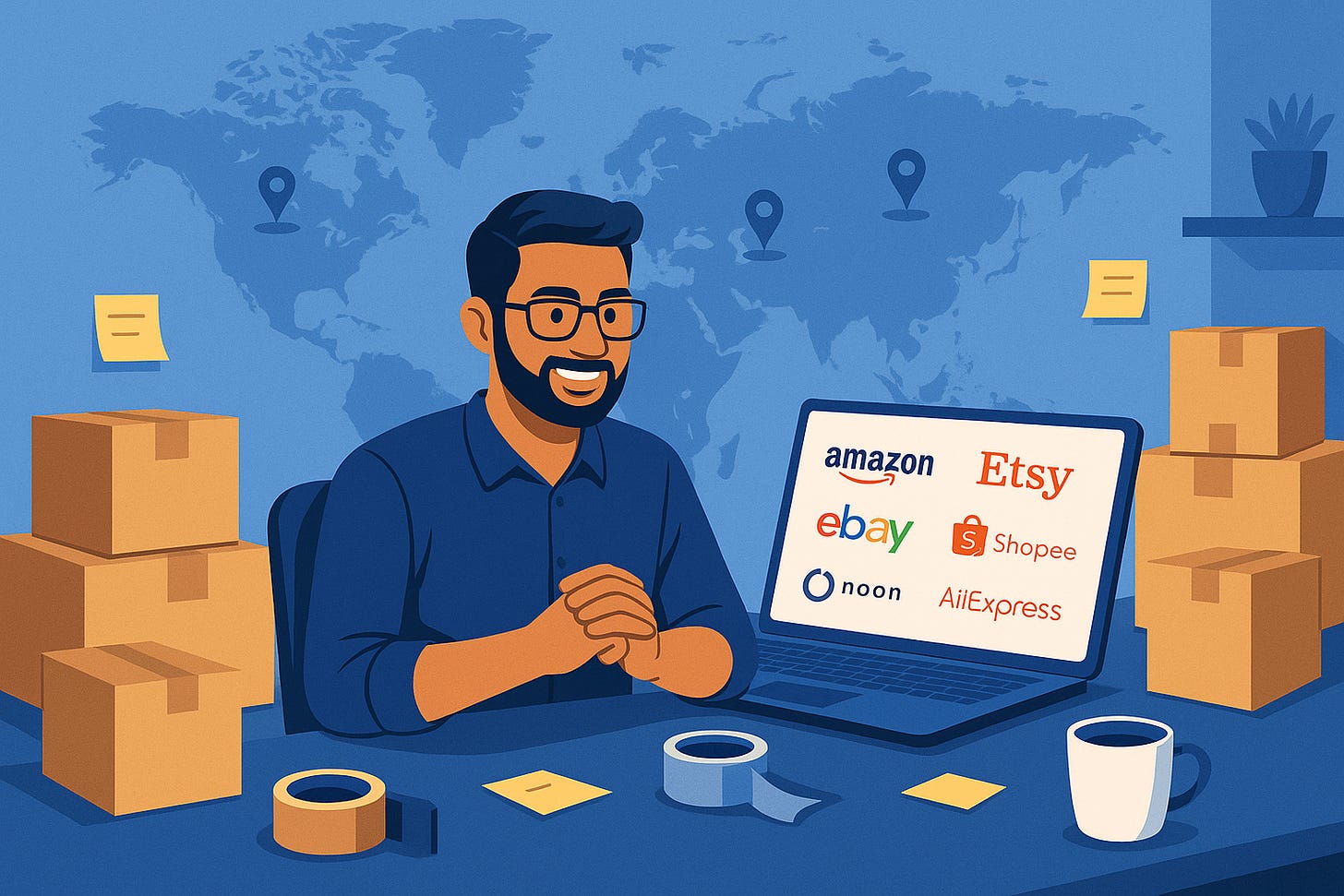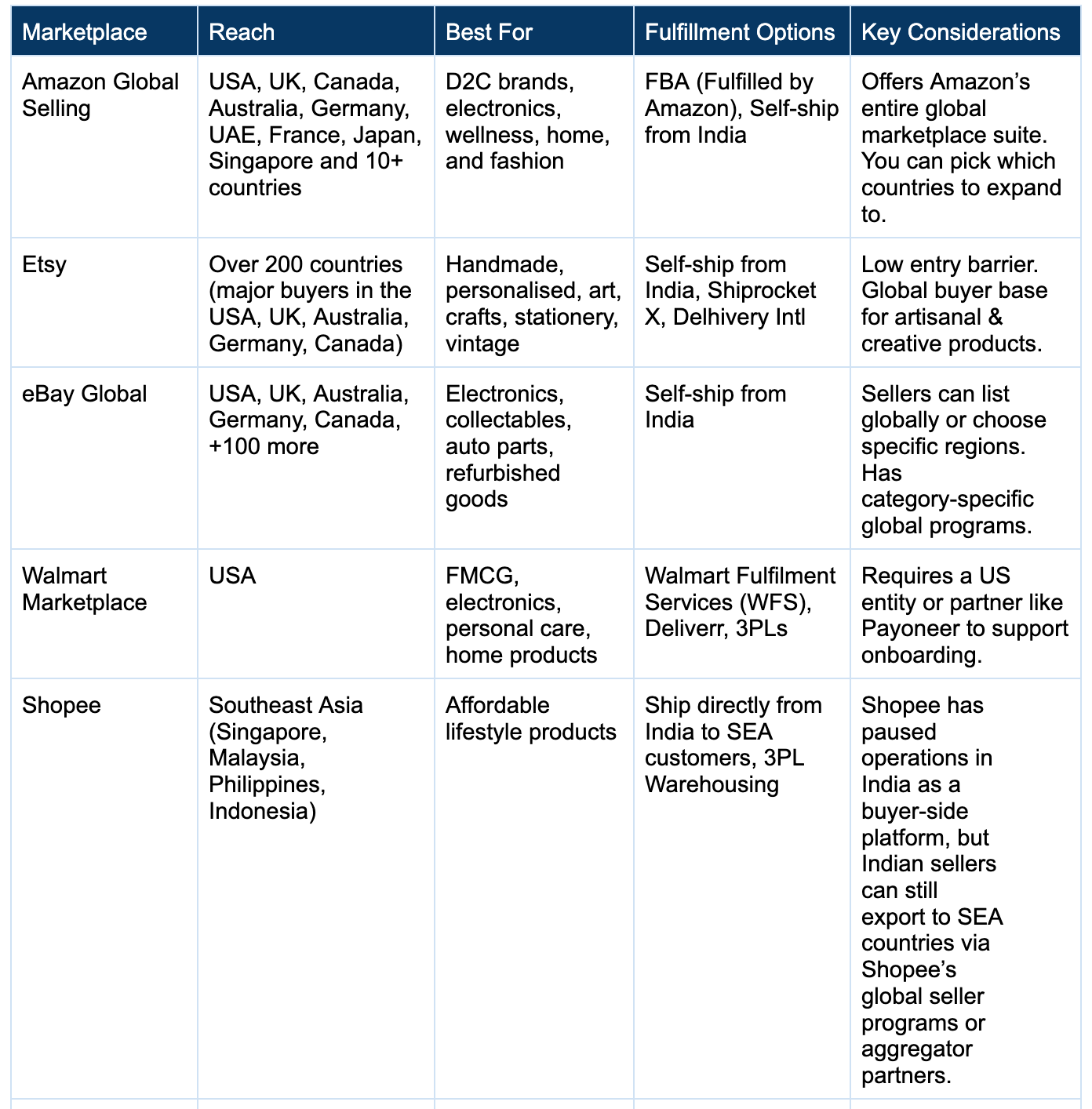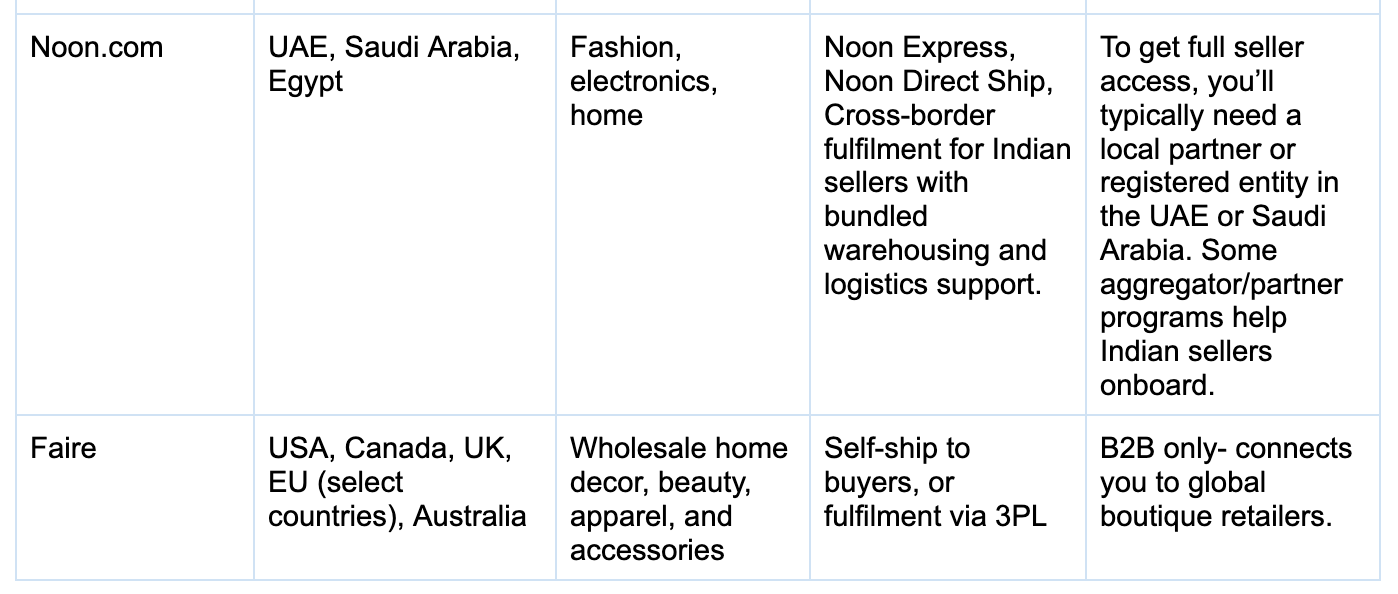Selling on Global Marketplaces: What Indian Founders Should Know?
Your next customer could be sitting in Dubai, Sydney, or London- all it takes is the right marketplace. Here’s what you need to know to start selling globally.
If you’re a founder in India, chances are you’ve dreamt about selling to customers beyond borders- a wellness brand from Kerala shipping to California, or a Jaipur-based crafts business finding fans in Berlin. That dream is more achievable today than ever before.
Global marketplaces like Amazon, Etsy, Walmart, and others have made it possible for Indian brands, whether bootstrapped or VC-backed, to sell internationally without setting up a local office or warehouse. But while the opportunity is massive, so are the details founders often overlook: from international shipping and packaging to currency conversions and compliance paperwork.
This guide is for people building great products in India who are wondering, “What does it really take to start selling globally?”
Let’s break it down.
Why Sell on Global Marketplaces?
With rising internet penetration and the growing appetite for unique, high-quality products, global marketplaces have become a lucrative gateway for Indian brands to go international, without heavy upfront investment. If you're unclear on how marketplaces can help, here's what they offer.
1. Access to Massive Global Customer Bases
Platforms like Amazon, Etsy, eBay, Walmart Marketplace, and Noon already have millions of monthly active buyers from countries like the US, UK, UAE, Canada, and Australia. Instead of building your own website and figuring out international marketing and logistics from scratch, marketplaces give you instant access to an audience actively looking to buy.
2. Low Entry Barriers & Infrastructure Support
Unlike traditional export models, where you needed a local distributor, warehouse, or retail presence, online marketplaces offer a plug-and-play system for global sales.
You don’t need a local office or warehouse.
Platforms like Amazon offer Fulfilled by Amazon (FBA) services where you send stock to their warehouse and they handle packaging, delivery, and even returns.
Etsy and others allow you to ship directly from India using FedEx, DHL, or India Post.
3. Build Global Brand Equity
Selling on platforms like Amazon.com, Etsy, or Faire helps your brand gain legitimacy in the eyes of international customers. Your packaging, reviews, response time, and consistency in fulfilling orders all become part of your brand reputation.
4. Repeatable & Scalable Model
Once you understand how to sell on one marketplace (say, Amazon US), expanding to others (Amazon UK, UAE, Australia, or even Walmart or Etsy) becomes easier.
Common Challenges While Selling on Global Marketplaces
1. Complex Documentation & Compliance
There are tonnes of export documentation, GST refunds, IEC registration, and labelling rules to go through, which can feel like a maze, especially when you're doing it for the first time.
2. High Logistics Costs & Shipping Delays
International shipping can eat into your margins. Long transit times or unexpected customs delays can also impact customer experience and repeat business.
3. Platform Fees & Currency Conversions
Marketplaces charge commissions, listing fees, and sometimes ad costs. Plus, fluctuating currency exchange rates and conversion charges from payment gateways can be tricky to manage.
4. Customer Support Expectations
Global buyers expect quick, professional responses. Handling refunds, disputes, or feedback in different time zones can stretch small teams. It’s also a significant logistical and cost challenge for a lot of founders.
5. Getting Visibility Among Global Sellers
Standing out on platforms like Amazon or Etsy is tough, especially when competing with thousands of global sellers. Investing in listings, SEO, and reviews might be a saviour.
Choosing the Right Global Marketplace
Each marketplace serves a distinct region and buyer type. Below is a detailed table of the top marketplaces, their buyer geographies, fulfilment models, and ideal categories:
Note: A fulfilment model is how your product gets from you to your customer. It includes storing, packing, and shipping orders. You can handle it yourself (seller-fulfilled), let the marketplace do it for you (like Amazon FBA or Noon FBN), or use a third-party logistics partner (3PL). Choosing the right model affects your delivery speed, costs, and customer experience.
How to Get Started?
Before you start shipping internationally, here are a few essential steps you should check off, though the order may vary based on your business priorities.
Regulatory and Tax Considerations
IEC Code (Import Export Code): Mandatory for all cross-border transactions. Issued by DGFT.
GST Implications: GST is not charged on exports, but you need to file LUT (Letter of Undertaking) and maintain export documentation.
Foreign Remittance Compliance: Track payments via Payoneer, Wise, or directly through bank integrations. Follow FEMA guidelines.
Customs and Duties: Understand the destination country's duties. Some platforms collect and remit duties (like Amazon’s IOSS in the EU).
Fulfilment and Logistics Options
Self-fulfillment: Cost-effective if volumes are low, but you manage the entire shipping, tracking, and returns process.
FBA (Fulfilled by Amazon): Amazon stores and ships your products. Higher cost, but ensures speed and customer satisfaction.
Third-party logistics (3PL): Ship products in bulk to a warehouse partner in the target country. Useful for scaling or selling across marketplaces. Providers like ShipBob, Flowspace, or Flexe handle last-mile fulfilment.
Cross-border shipping tools: ShipRocket X, Pickrr Cross-border, Amazon Easy Ship, or Delhivery International offer reliable logistics and tracking.
Cultural and Customer Expectations
Packaging Matters: International customers expect clean, branded packaging, especially on Etsy or Faire.
Product Descriptions: Localise spellings and measurements. Use inches/pounds for the US and cm/kg for the EU.
Customer Support: Be responsive. Time zone management is key, and automation tools like Gorgias or Freshdesk can help.
Returns Policy: Set clear guidelines. Some marketplaces require sellers to accept returns, so plan for that cost.
Pricing and Currency Strategy
Factor in:
Marketplace commission fees (10–20%)
Payment processor fees (2–4%)
Logistics and packaging
Currency conversion and fluctuations
Use pricing calculators offered by platforms (Amazon’s FBA calculator, Etsy fee calculator).
Consider tools like Razorpay International, Payoneer, or Wise to manage remittances efficiently.
Marketplace Optimisations
High-quality listings: Invest in professional photography, keyword-rich titles, and compelling copy.
Reviews & Ratings: Start with a few orders to friends or through micro-influencers to generate social proof.
Ad Tools: To increase visibility, use sponsored products (Amazon) and promoted Listings (Etsy/eBay).
Consistent Inventory: Always keep your stock levels updated to avoid account suspensions.
Final Tips Before You Start
Start small. Test 2–3 SKUs in 1-2 markets
Buyers can't touch your product, so invest in branding and pleasing visuals
Focus on on-time delivery and customer communication
Use analytics to track best-selling geographies and optimise
Join communities like Amazon Sellers India, Etsy India Facebook Groups, Razorpay Rize Xport+ and cross-border eCommerce webinars,
Conclusion
Every marketplace has a different audience, buying behaviour, and logistics ecosystem. The trick is to find your fit. Maybe your handmade lifestyle products resonate with premium buyers in the Middle East, or your affordable, practical innovations catch fire among value-driven shoppers in Southeast Asia. Once you see traction in one market, you start building muscle, understanding how listings work, how to price competitively, what logistics partners to use, and how to localise your brand story.
That’s the beauty of global marketplaces: they are built for repeatability. Once you crack one, the same setup (with a few tweaks) helps you unlock the next. And you don’t have to start big. Even a few consistent weekly orders from a new country are a win. It means your brand is travelling. Your product is being discovered. You’re no longer just building in India, you’re building from India, for the world.
So if you’ve been sitting on the idea of going global, this is your nudge: Start with one product, one country, one channel.








By